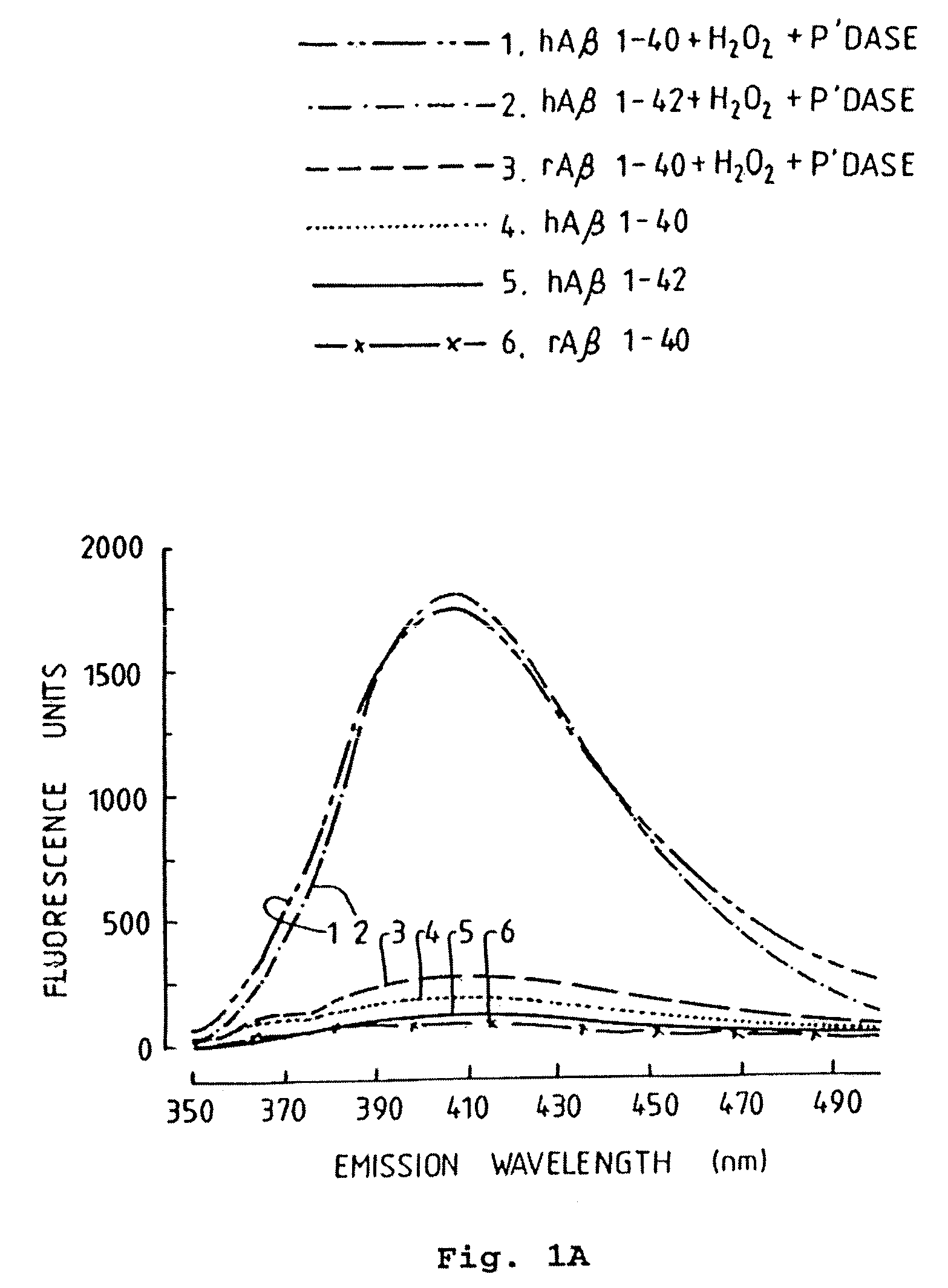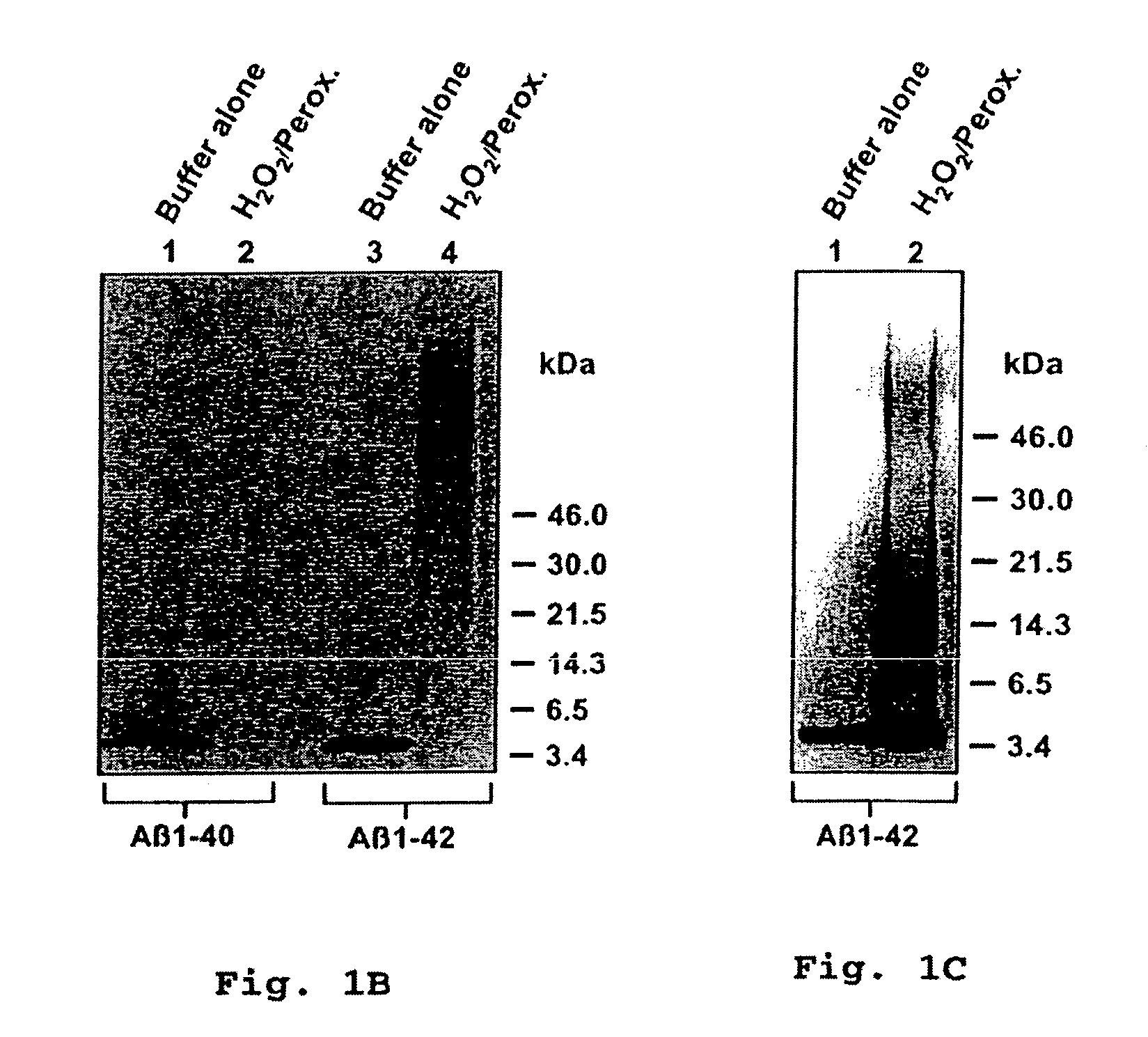Neurotoxic oligomers
a neurotoxic and oligomer technology, applied in the field of immunotherapy, can solve the problems of limited success of drugs, elusive rational chemical and structural basis for developing effective drugs to prevent or cure diseases, etc., and achieve the effects of moderate immune response, modest positive reaction, and raised immune respons
- Summary
- Abstract
- Description
- Claims
- Application Information
AI Technical Summary
Benefits of technology
Problems solved by technology
Method used
Image
Examples
example 1
Peroxidase-Catalyzed Aβ Polymerization is Accompanied by Formation of Tyrosine Cross-Links
[0080]We initially tested whether peroxidase-catalyzed oxidative conditions could promote Aβ polymerization by measuring the fluorescence of human Aβ1-40, human Aβ1-42, and rat Aβ1-40 (50 μM) incubated with or without H2O2 and peroxidase for 1 day. Fluorometric analysis of these samples indicated a marked increase in fluorescence in samples containing Aβ1-40 and Aβ1-42, as illustrated in FIG. 1A. These results are similar to those previously reported for synthetic human Aβ, achieved at a much higher peptide concentration, 1.25 mM (Galeazzi et al., 1999). In contrast to the behaviour of the human-sequence Aβ peptide, no increase in the fluorescence signal of rat Aβ1-40 was observed after incubation with H2O2 and peroxidase, as also shown in FIG. 1A. This suggested that the fluorescent signal was specific for tyrosine-oxidation products of Aβ, since rat Aβ lacks tyrosine (Shivers et al., 1988).
[0...
example 2
Polymerization Occurs Under Physiological Conditions
[0082]To determine whether H2O2 / peroxidase-induced polymerization of synthetic Aβ occurs under conditions which approached physiological, we also incubated Aβ1-42 at 10 nM with H2O2 at 1 μM and peroxidase (7.5 μg / ml) in PBS at pH 7.4. We observed that SDS-resistance of the peptide was again induced, as shown in FIG. 1C; however, oligomers of lower apparent molecular weight than those generated by using higher concentrations of substrates were generated, as illustrated in FIG. 1B. The migration on SDS-PAGE of the apparent Aβ polymers under these conditions suggested the formation of dimers (8 Kd), trimers (13 kD,) and tetramers (17 kD).
[0083]As shown in FIG. 2A and FIG. 2B respectively, fluorescent analysis of Aβ purified from AD-affected post-mortem brain tissue revealed the characteristic spectrofluorometric pattern of tyrosine cross-linked species; this purified protein migrated as apparent oligomers on SDS-PAGE, as previously de...
example 3
Tyrosine Cross-Linking of Oligomers
[0084]To confirm that the apparently oligomeric human amyloid-derived Aβ was tyrosine cross-linked, a sample was hydrolyzed and then analyzed by MALDITOF-MS. This analysis, illustrated in FIG. 3A, indicated a peak corresponding to 361 Da (m / z 361, representative of M+H), thereby confirming the existence of DT or iso-DT in the sample. A smaller peak corresponding to 540 Da was also detected, consistent with the presence of TT or P. Other prominent peaks were detected at 247, 263, 307, 309 and 538 Da; these may represent other modifications to Aβ amino acids, such as carbonylation (Atwood, 1999) and other amino acid cross-links.
[0085]More abundant fragments from the hydrolysis of human Aβ were also detected at 423 and 425 Da (ratio 3:2), suggestive of Cu binding to DT or iso-DT (Cu mass=63 & 65 Da, ≈2:1 natural isotope abundance).
PUM
| Property | Measurement | Unit |
|---|---|---|
| Immunogenicity | aaaaa | aaaaa |
Abstract
Description
Claims
Application Information
 Login to View More
Login to View More - R&D
- Intellectual Property
- Life Sciences
- Materials
- Tech Scout
- Unparalleled Data Quality
- Higher Quality Content
- 60% Fewer Hallucinations
Browse by: Latest US Patents, China's latest patents, Technical Efficacy Thesaurus, Application Domain, Technology Topic, Popular Technical Reports.
© 2025 PatSnap. All rights reserved.Legal|Privacy policy|Modern Slavery Act Transparency Statement|Sitemap|About US| Contact US: help@patsnap.com



